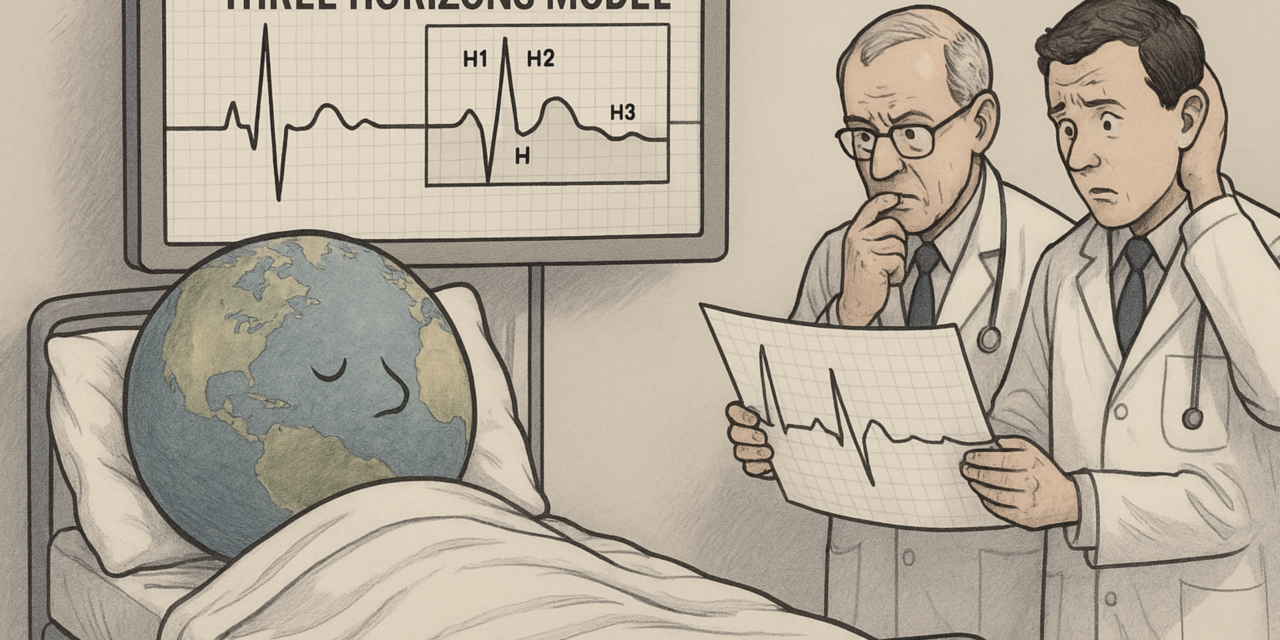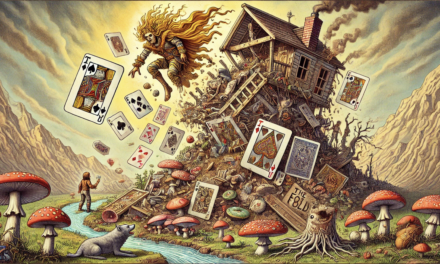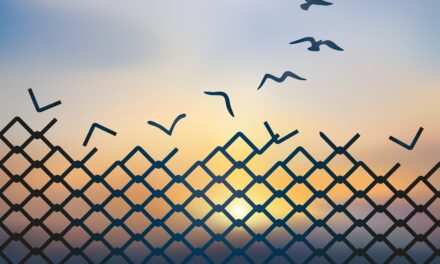We’ve learned to read the planet like a patient. To measure the pulse, scan the systems, predict collapse. But healing isn’t something we do to the Earth. It’s something we remember how to do with her. The real question is not: “What does the ECG say?” but “How do we return to rhythm?”
I. Waking to the Field
At first glance, the image above may feel familiar. The Earth, laid out like a patient, surrounded by experts reading a scan. It echoes the logic of our time: diagnose, predict, intervene. But look again—what is that rhythm the doctors are puzzling over? Why does it look so much like a heartbeat?
This image bears the subtle watermark of the modern worldview. It casts us as outside observers—fixers of systems, analysts of decline. And yet, what if that worldview is itself part of the illness?
There is another way to see. A way that does not begin from detachment, but from relationship. A way that does not rush to prescribe, but listens for what is already speaking through soil, breath, tide, and time.
There is a rhythm beneath our feet. A pulse. A field of relation that holds us, shapes us, and—if we learn to listen—sings to us.
But for many of us raised in the Sea of Modernity, this rhythm has become inaudible. Replaced by the hum of machinery, the flicker of screens, and the tick of clocks, we have mistaken momentum for meaning and efficiency for life.
Modernity taught us to see the world as a set of parts, systems to be managed, landscapes to be engineered. It trained us to believe that progress is always forward, that life unfolds in straight lines. It whispered to us that we are separate. Individuals. Units of labour and consumption.
But the truth is far more beautiful. We are not separate. We are threads in a vast, vibrating web. We are breath moving through a lung that is shared by forests, oceans, elephants, fungi, and sky. We are the Earth becoming aware of itself in one shimmering, dangerous, extraordinary moment.
Just the other night, while exploring these ideas with my final-year medical student granddaughter Lucy, she noticed something remarkable. We were looking at the Three Horizons model—a framework for thinking about transformation. She paused, tilted her head, and said, “It looks like a heartbeat.”
And indeed, it does.
That comment shifted something in me. Because yes: what if the change we need isn’t a new destination, but a return to rhythm? What if Horizon 3 isn’t far away in the future, but already beating within us, waiting to be remembered?
To feel the Earth’s heartbeat is not mystical. It is metabolic. It is what your body already knows but your culture may have taught you to forget.
This post is an invitation to remember.
II. A Song for the Field
We live inside a rhythm.
Not metaphorically, but metabolically.
The Earth breathes: inhaling forests, exhaling cities.
Its heartbeat is not a metronome—
it’s a mycelial thrum,
an oceanic surge,
a tectonic patience.
Most have forgotten.
We mistake the machine’s purr for life’s pulse.
We count time in deadlines, not seasons.
We seek solutions when the field asks for attunement.
But the field is still here.
Still humming.
Still holding.
To feel it, you must slow down.
You must step outside the frame.
Lie on the ground.
Hold the silence long enough for the beetles to return.
Let the wind un-narrate you.
You do not need to earn your place in the web.
You are already woven.
This is not a metaphor.
This is your body’s truth.
This is the whisper beneath your breath.
The blink that becomes a heartbeat.
The heartbeat that becomes a song.
A song not of mastery, but of belonging.
A song not to fix the world,
but to remember how to live inside it.
Welcome back to the field.
III. Practices for Re-Attunement
This remembering is not just poetic—it is practical. The Earth’s rhythm can be felt, known, and responded to in our daily lives. Here are a few small ways to begin:
1. Notice the Pulse:
Find a moment each day to pause. Step outside. Feel the air. Listen—not to what you expect, but to what is actually there. This is not a mindfulness technique. It’s a relational act. A gesture of reconnection.
2. Walk Without a Goal:
Let your feet move without a destination. Let the land guide you. Try walking at the pace of curiosity instead of efficiency. Pay attention to what draws your gaze.
3. Attend to the Invisible:
The relational field includes fungi, bacteria, microclimates, ancestral memories. Begin noticing what your culture ignores. Begin wondering who or what you’ve forgotten to thank.
4. Speak Differently:
Use language that invites relationship, not dominance. Replace “resources” with “relatives.” Speak of the Earth not as “it” but as “she” or “we.” Notice how this changes your orientation.
5. Learn Together:
Gather with others to share stories, questions, and insights about the field. Create spaces where complexity is welcome, and where silence can be held as sacred.
6. Act from Resonance, Not Reaction:
When responding to crisis, ask: “Is this action reinforcing separation or deepening relationship?” Let your doing arise from a deeper listening.
These are not prescriptions. They are invitations. Ways to tune your instrument back into the larger symphony of life.
Because in the blink of a heartbeat, everything can change.
And perhaps, if enough of us remember, the field will sing a new rhythm through us all.
Terry Cooke-Davies
5th April 2025
Author’s Note
This piece emerged through a dialogue between myself and ChatGPT-4, a large language model trained by OpenAI. I take full responsibility for the ideas, insights, and intentions it carries. The language was shaped collaboratively—sometimes I offered the vision and the AI found the words; other times, the AI offered a phrase and I followed its thread. Our process is not instrumental, but relational: more like co-composing than commanding. I hope this post not only shares new ideas, but also quietly models a new way of being in creative partnership—with each other, with machines, and with the living world.
Terry Cooke-Davies
5th April 2025






